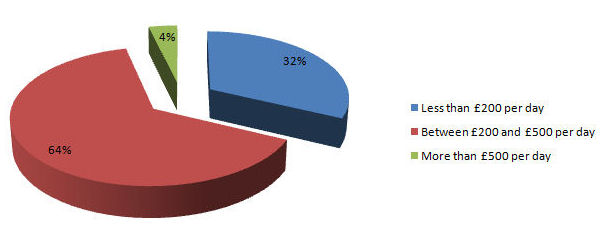The PR community – much like the rest of the creative and marketing world – is evolving to work in different, more flexible ways and freelancing is now a growing resourcing strategy for many agencies and brands. The latest Freelance Landscape survey, based on research by specialist recruitment firm Major Players, shows that PR professionals, who historically work long hours and across multiple projects and mediums, are valuing a better work-life balance and a more varied and inspiring career across different agencies over a bigger pay packet.
These motivations were voiced by over 1,000 marketing professionals surveyed. Among professionals with a PR job, 57 per cent of freelancers rated greater choice over their projects as the most appealing aspect of freelancing while for 25 per cent it was gaining greater creative experience and opportunity. Only 11 per cent stated it was to achieve higher financial reward than the permanent equivalent.
The daily rates of PR freelancers

The least appealing aspect was periods of inactivity between assignments, with 42 per cent stating this reason, followed by 28 per cent most concerned with the comparative insecurity of freelancing – a cancelled assignment for example.
“Freelance PR is becoming an increasingly attractive proposition for our candidates,” says Major Players' head of PR, Karl Ramsaran. “We are seeing increasing numbers of career freelancers wanting to take on exciting contract briefs. People like the buzz and the freedom of choice and of course freelancers are paid more than their permanent equivalent. Our survey also found that fitting work around family life and maintaining a certain distance from office politics were key incentives for freelancing."
“New regulation is also ensuring freelance professionals an equal footing with their permanent colleagues. The Agency Workers Regulations (AWR) brought in last year affords freelancers the same rights as permanent workers after a 12-week period.”
The evidence shows that contracting continues to be a massive spark within the PR world – with 70 per cent freelancing through choice. Only 23 per cent of those surveyed are freelancing because they could not find a permanent position or for other reasons. Freelancing has also undoubtedly been boosted by the more challenging environment since 2009, as 38 per cent of respondents began freelancing after this point.
“The buoyancy of freelancing is a reflection of a changing employment environment, as well as PR professionals wanting a more flexible work life balance, it is has also become a necessary choice as PR agencies adapt to stricter economics,” says Ramsaran. “Our clients bring in freelancers to add support or experience without the need to pay for a permanent member of staff and to drive creativity with fresh eyes. Freelancers are now valued for their ability to shake things up and produce results in a short space of time.”
Daily rates
The pie chart shows above the breakdown of daily rate across PR freelancers with the majority, 64 per cent, commanding between £200 and £500 per day. 32 per cent are earning less than £200 a day and 4 per cent are earning over £500 per day.
Key statistics
-
64 per cent of freelancers earn between £200 to £500 per day.
-
57 per cent rate “greater freedom of where, when, who and how” as the most appealing aspect of freelancing.
- 11 per cent rate “greater financial reward” as the most appealing aspect of freelancing.
Compared to other creative freelancers PR fared less well in daily rates, 32 per cent of PR freelancers are earning less than £200 a day, compared to only 21 per cent of creative and design and 16 per cent of integrated professionals. However, this seems to be an indication of a higher level of contract jobs as opposed to shorter assignments or temping which is more common in other creative sectors. “We are seeing a wide variety of contracts from one month, two months and so on up to six months or even a year,” says Ramsaran. “These contracts are a mixture of project-based roles and working across multiple brands.”
Background
This survey forms part of a larger investigation into the changing employment landscape across the whole of the UK by Randstad, Major Players’ parent company. The result is The Navigator report. To order a free copy of the Navigator report please click here.
PR Masterclass: The Intersection of PR and GEO
Join PRmoment for a Masterclass featuring 10 of the industry’s foremost experts. You will walk away with a clear, actionable strategy for adapting your content to an AI-first search environment.
Taking place on Wednesday 25th February in London, both virtual and in person tickets are available.
Early bird ticket sale ends Friday 9 January.
PR MasterclassIf you enjoyed this article, sign up for free to our twice weekly editorial alert.
We have six email alerts in total - covering ESG, internal comms, PR jobs and events. Enter your email address below to find out more:









